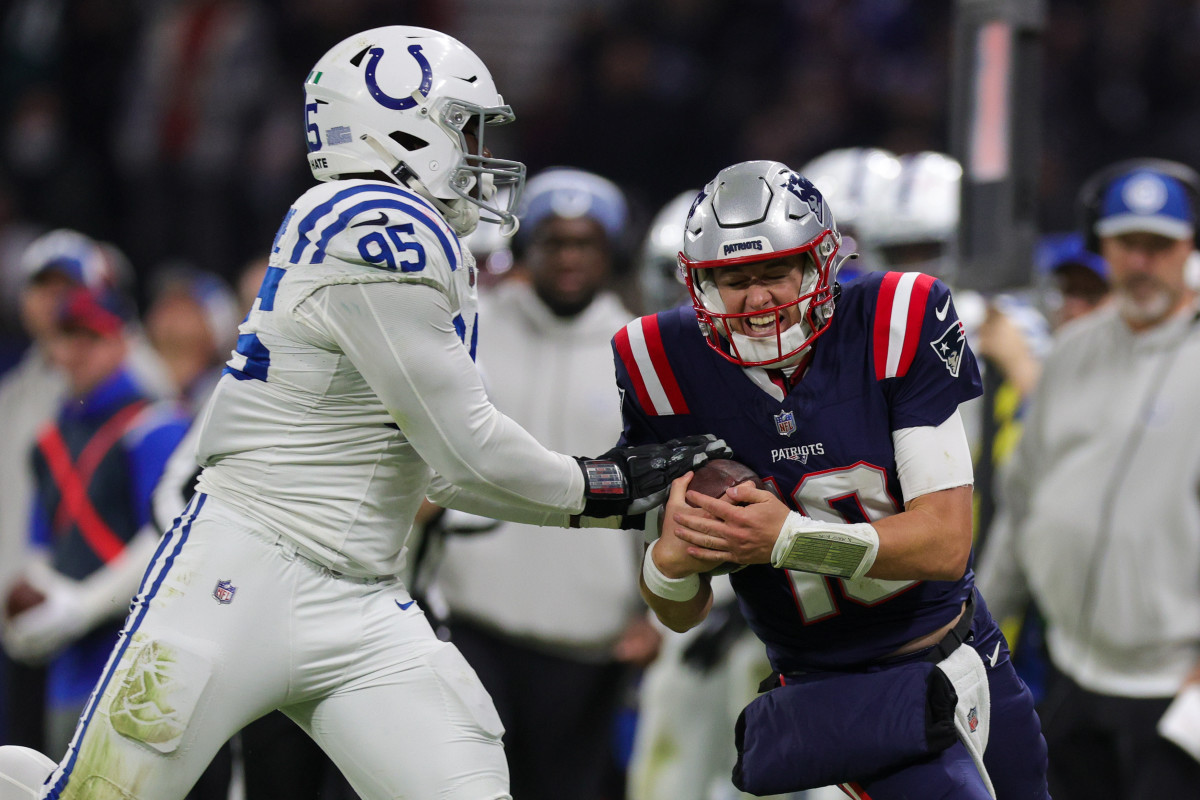New England Patriots-Indianapolis Colts Notebook: Mac Jones’ Last Hurrah?
As the New England Patriots walked from the field at Frankfurt Stadium on Sunday, a sense of finality seemed to grip the team as it accepted its Week 10 loss 10-6 loss to the Indianapolis Colts at Deutsche Bank Park in Germany.
For the first time since 2000, the Pats are a 2-8 football team — a harsh reality for a franchise once considered a stalwart atop the standings of both their division and conference. However, this current iteration of Patriots were able to muster only six points in a game which team owner Robert Kraft “badly” wanted to win.
Accordingly, New England heads into its bye week seemingly acceptant of their fate to play the remainder of their games with an eye already focused on 2024. While mathematical elimination from postseason contention is presently impossible, the Patriots are now 0-6 in non-division games and remain the NFL's only team without a win outside of their division.
With seven games remaining on their season slate, here is a deeper look at the Patriots Week 10 loss to the Colts.
Mac Jones’ Swan Song?
While subpar pass protection from the offensive line, and the inability for receivers to gain separation have played their part, Mac Jones’ performance may have precipitated the end of his tenure as the Pats starter. The third-year quarterback completed 15 of 20 passes for 170 yards, while having absorbed five sacks and one costly fourth-quarter interception.
Jones’ interception was a short-armed fade thrown from his back feet intended for an open Mike Gesicki in the end zone. Instead, his throw landed in the waiting hands of defensive back Julian Blackmon. To his credit, the Alabama product took full responsibility for the errant throw — referring to his mistake as “terrible.”
Once again, Jones' inability to make sound decisions when most needed has caused an obvious regression from which he seems ill-suited to recover. It should be noted that the pressure under which he played for much of the game gave him little-to-no choice but to force the ball into bad situations, especially with the Colts defenders taking away his preferred routes and targets. Ultimately, Jones' discomfort in the pocket has led to a foundering of both his confidence and his mechanics. New England's coaching staff must prioritize their attempts to repair both his timing and process. If they are unable to do so, the Pats may have no choice but to make an in-season change at quarterback.
Unfortunately, for the Patriots, such a switch is unlikely to produce improved results. In relief of Jones on New England’s final drive, the second-year passer completed only 3 of 7 passes for 25 yards, with an egregious interception thrown into triple coverage to end the Pats comeback attempt.
In the final analysis, it is hard to envision a scenario in which Jones is able to effectively rebound as the Pats starting quarterback. However, Zappe’s limited sample size clearly shows that he is not the answer either. As a result, New England has a quarterback problem without a clear solution in sight.

Offensive Line Struggles Against Pass Rush, Better with Run Blocking
With Trent Brown having remained in Foxboro due to both personal reasons, as well as an ankle injury, practice squad elevation Conor McDermott took the starting spot at left tackle. The remainder of the line was comprised of Cole Strange at left guard, David Andrews at center, Sidy Sow at right tackle and Mike Onwenu at right tackle. After protecting Jones from being sacked just one week earlier, the unit surrendered five against the Colts, four of which came on third-down attempts. New England once again displayed futility on third-down, converting only 6 of 14 attempts.
The offensive line fared much better in run-blocking duties. Their collective ability to move the line of scrimmage helped facilitate some of the gap running plays which allowed the Pats to rush for 167 yards — 88 from Rhamondre Stevenson, 54 from Ezekiel Elliott and 25 from Mac Jones. While this was far from being the line’s best effort, their performance in run blocking gave the Pats a chance to keep the game competitive.
Run Defense Steps Up
Though team captain Ja’Whaun Bentley was inactive due to a lingering hamstring injury, New England’s middle defenders embodied the “next man up” philosophy to notable success. Indianapolis star running back Jonathan Taylor was held to just 3.0 yards-per-attempt, totaling 23 carries for 69 yards and the game’s lone touchdown. Taylor’s backfield mate, Zack Moss, took only one handoff for two yards.
Linebacker and practice squad elevation Calvin Munson helped to mitigate Bentley’s absence, while middle linebacker Mack Wilson Sr. played an off-ball role. Safety Kyle Dugger stepped into the role of defensive traffic director, earning a key run stuff on a second-quarter third-and-1 which forced a Colts punt.
Special Teams Once Again Fails the Test
Despite being a team known for placing a premium on special teams prowess, New England continues to exhibit futility in the game’s third phase. While attempting to block a punt using a planned rush with nine players at the line of scrimmage, the Colts were able to extend Rigoberto Sanchez’s punt to 69 yards by taking full advantage of the absence of a Pats returner in the deep part of the field.
Rookie kicker Chad Ryland also missed a 35-yard field goal in the third quarter, ensuring that the Pats would not capitalize on cornerback Myles Bryant’s interception of Colts quarterback Gardern Minshew. Lastly, the coverage team surrendered a 42-yard kickoff return by a former AFC East rival Isaiah McKenzie to open the fourth quarter, leading to a 51-yard Matt Gay field goal for Indianapolis.
Up Next:
The Patriots head into their bye week with a 2-8 record. They will travel to East Rutherford, NJ for a Week 12 matchup with the New York Giants (2-8) on Nov. 26 at MetLife Stadium.
